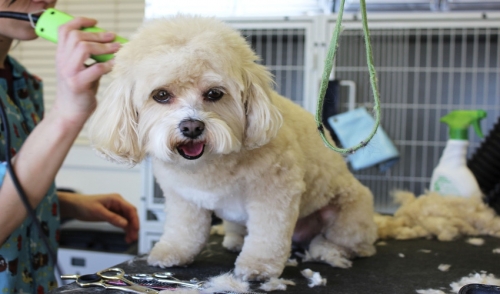{article.name}
If You're Shaving Your Dog – Don't!

- Share this:
- Share on Facebook
- Pin on Pinterest
- Tweet on Twitter
Many dog owners believe shaving is good for their pet, especially to cool off in summer, but even one shave could do irreparable damage to a dog's coat and make it more uncomfortable.
Dogs You Can Shave and Dogs You Can't
Some dogs can easily be shaved without causing problems – many short-haired breeds are fine to shave, but there are still risks with the procedure and it isn't necessary for the dog's health or comfort. Long-haired breeds with double coats, however, should never be shaved because of the problems that can result from damaging their intricately balanced coats. Dogs such as golden retrievers, German shepherds, Siberian huskies and any dog that seasonally sheds huge clumps of fur (part of its undercoat) should never be shaved.
Problems With Shaving
It is a misconception that shaving will help keep a dog cool on hot days. A dog's coat is a natural insulator, and removing that hair only allows the heat and sunlight easier access to the skin, causing overheating and discomfort, as well as additional problems such as…
- Sunburn: A dog's skin can be very sensitive, and a good fur coat blocks dangerous UV radiation that can cause sunburn. Sunburns can be just as painful for dogs as they can be for humans, and in severe cases, sunburns can increase the risk of developing skin cancer.
- Clipper Injuries: The chattering blades of shaving clippers can spook dogs that aren't used to the noise or are reluctant groomers, and if the dog twitches or moves unexpectedly, it is easy for clippers to cause severe cuts. Clippers can also grow very hot when in use, and even brief contact with a dog's skin can cause a painful burn.
- Skin Problems: When a dog's coat is cut too short, ingrown hairs can develop that can cause painful bumps or lesions. If the dog is already prone to skin problems such as dryness or sensitivity, shaving will only make those problems worse.
- Coat Damage: The two layers of a dog's coat – the dense, softer undercoat and the long, coarse guard layer – grow at different rates, and shaving the layers off together can permanently damage the coat so it is no longer balanced to provide adequate insulation and protection. As a result, the coat may grow back in uneven patches or may have a ragged, unkempt texture that cannot be groomed appropriately.
Other Shaving Excuses
Some dog owners believe that shaving is also useful for other reasons, which have also been proven false.
- Shaving Minimizes Allergy Problems – False!
Shaving will not improve problems for anyone allergic to dogs, and can even make those problems worse. Allergic reactions are not caused by the dog's fur, but by dander, skin flakes, oil and saliva. If the dog is shaved, more dander and skin will be released, it will be easier to pick up oil from petting the dog, and the dog may pant more or lick itself more frequently because of the discomfort from being shaved, all of which can aggravate allergies.
- Shaving Will Reduce Shedding – False!
While the few days immediately after shaving your dog may seem to be shed-free, the dog will soon start to shed hair again, only it will now be in shorter lengths that are messier and can be more widespread through the house, working their way into carpeting, upholstery and other fabrics with better ease than long hair, making cleanup even more difficult.
Safer Shaving Alternatives
Instead of shaving your dog, there are other options that can help keep your pet cool and comfortable, and can prevent other problems with its coat.
- Regular Grooming: Thorough brushing will remove much of the loose fur of your dog's coat, cooling them far more effectively and safely than shaving. This will also minimize shedding. Good shampooing on a regular schedule will also minimize dander and keep the coat in great condition.
- Coat Trimming: It is easy to trim the longer parts of your dog's coat to minimize bulk, but do not remove too much length. A quick trim can make your dog more comfortable and improve its appearance.
- Provide Shade: On the hottest days, it is best to keep your dog inside in a cool area, or else be sure its outdoor kennel or run is well shaded.
- Provide Water: Dogs should always have plenty of fresh, clean, cool water to drink, especially when it is hot. A well-hydrated dog can pant and regulate its own temperature more effectively.
- Adjust Activities: On hot days, it is best to walk or exercise your dog early in the day or late in the evening when the temperature is cooler, avoiding exertion during the hottest hours.
Shaving your dog is never necessary, and can do far more harm than good for your pet. Understanding the risks of shaving and what alternatives are best can help every dog owner provide the best care for their canine companion.
Special Offers

We offer FREE home delivery—no minimum purchase required! ( Print This )
Company Events
We currently do not have any events scheduled.

Comments